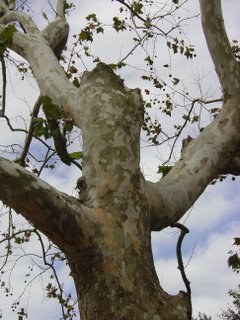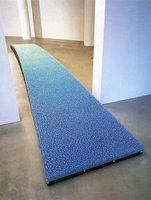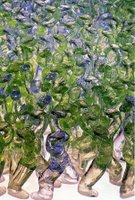Day 344 - What You Say Is What You Get
 Journalists walking with me through the Matagorda County Birding & Nature Center last month couldn’t understand how a tree could make a woman cry.
Journalists walking with me through the Matagorda County Birding & Nature Center last month couldn’t understand how a tree could make a woman cry.(Click on the tree to get a better look. Use your Back Button to continue reading.
 Well, who else but a military mom would think, That camo tree reminds me what my son will look like holding his arms out to hug me when he comes home in a few weeks?
Well, who else but a military mom would think, That camo tree reminds me what my son will look like holding his arms out to hug me when he comes home in a few weeks?Did I see it before it happened? You bet.
Did anybody else get it? I doubt it.
Despite more than fifty years of investigation, the issue of whether, and to what degree, language influences thought is still hotly debated. According to Dr. Debi Roberson, professor of psychology at the University of Essex, recognition of certain colors is influenced by the words you have to describe them.
The relativist theory may help to explain, for example, why some native English-speaking children, familiar with the rainbow of colors in the Crayola 64-pack, actually can tell rust from brick and moss from sage, while children who grow up speaking languages with fewer color names lump such hues together. Or why tribes without names for numbers cannot count.
Most authorities agree whether or not a language distinguishes between green and blue influences the perception of these colors. By extension, language influences the way we perceive the world.

Although the Korean language makes no distinction between the singular and the plural, native Korean artist Do-Ho Suh straddles the divide between the singular and the collective in his sculpture,
Blue Green Bridge.

From a distance, Suh's Bridge looks like one solid mass of color. The perception of two colors, blue and green, is dependent solely on the viewer's movement through space to gaze more closely on the work.
Journalist blogger Michael Yon explores how perceptions are influenced by pictures and words by comparing two slide shows—both accurate, each limited in scope. Although the differences are subtle, perhaps purely rhetorical, Yon believes the consequent impact, and how it influences public opinion, is something closer to cataclysmic.
It’s interesting to compare these two montages. The first from an unattributed source, perhaps even a work of propaganda, shows people at their best, braving terrorists to vote in Iraq, then dipping their fingers in the purple ink, and smiling with pride, strength and hope. The second montage by MSNBC, conveys the ultra-violence of nature against man, the cruelty of man against man, and helps explain why we want the world to be more like the impression we are left with after the “propaganda” montage.Curious? Click here to read his entire post and watch the two montages.
The Stanford Encyclopedia of Philosophy provides this formula: “Large differences in language lead to large differences in thought."
Maybe that’s why the Bible applauds Noah, who acted by faith when he built the ark, since rain wasn’t yet in his weather vocabulary.




<< Home